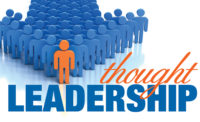Certainly over the past several decades, the plethora of “leadership” books has grown to the point that the topic could fill a metropolitan library. All of us have read our fair share of leadership books or have been asked or ordered to attend a leadership training session in our organization or partake in a “leadership experience” of some sort at a relaxing venue with dramatic vistas.
A different approach
Dr. J. Gerald Suárez, a friend and mutual colleague of the late Dr. Russell Ackoff, recently published a 158-page leadership book, ”Leader of One,” focused on the use of the idealized design methodology to transform your approach to applying leadership in your life and work.1
Dr. Suárez uses the three-bucket metaphor wherein one represents the past, the present, and the future. Ask yourself, how much of your day is devoted to fixing safety problems… the past bucket? How much of what you do fits in the present bucket, such as managing safety crises? How much of what you do in your day involves reflecting and visioning… the future bucket? Most, if not all of us, spend all of our time jumping back and forth from the past bucket to the present bucket.
So what does Dr. Suárez suggest to stop this jumping back and forth? He presents a framework that is illustrated in this cycle of transformative initiatives:
Contemplation
As a Leader of One, you have the ability to focus on what you would like to see happen regarding your safety program and what you will need to do in order to bring it about.
Dr. Suárez provides four questions worth contemplating as you think about the safety future you would like.2 I have presented his questions with a safety spin.
• Do you see your organization’s safety future as predetermined or inevitable or do you believe that a future safe workplace can be created?
• Do you think that safety in general was better in the past? Do you look to the past for inspiration and solutions?
• Are you frequently forecasting the future of safety in your organization based on the past?
• Do you give serious thought to tomorrow or are you satisfied with the status quo?
Desire
In this phase, determinine your purpose and passion for the safety future you have contemplated. A sampling of the questions3 Dr. Suárez offers for you to discover your passion include:
• What are you inspired by and why?
• Who inspires you the most?
• What makes you feel productive?
• What makes you feel proud of yourself?
• What commitment or initiative have you been postponing?
• How does procrastinating make you feel?
• What would you like to know more about?
Regarding your purpose, Dr. Suárez offers the following4, a sampling of which I have selected:
• What activities do you enjoy the most?
• What kind of work would you do for free?
• Are you chronically tired at the end of each workday?
• What gives you a deep sense of satisfaction? Accomplishment?
• What issues or causes are you most moved by?
• What safety problem or challenge would you like to see solved?
• How would you like to serve others if time were abundant?
Here are some hints for you as you search for your passion and purpose.5 Consider keeping a “passion journal” wherein you identify those activities during the day that made the day fly by and inspired meaning into your life and work. Figure out the energy killers in your life that drain your enthusiasm. Ask people around you what they think of you. Finally, write a statement of desire and do your best to externalize the statement creating a sense of personal connection.
If safety, health or environment is not your passion, for your own wellbeing find another occupation. Trust me, you will never regret it.
Design
In this phase we turn to the systems thinking methodology called Interactive Planning to design the future. Don’t use the present to plan for the future, but use the future to plan for the present.6 Plan backward. Now is when you design the ideal requirements and specifications and search for the closest approximation of the ideal you desire. The most effective means to create the future is to continuously approximate or close the gaps between the ideal and the present.
Sustaining change can be daunting. Dr. Suárez provides an approach that allows change to endure. He draws upon an expanded version of Scherkenbach’s Physical, Emotional, and Logical Model.7
To endure you must address change from these three domains. Be mindful, you are not seeking a balance of these domains, but an integration of the three to facilitate an enduring change.
To complete the Design phase, Dr. Suarez recommends the use of the idealized design approach. Begin by answering the following question, “If I were to create my ideal future with anything I wanted, what would I like it to be?” Ensure that whatever you create is technologically feasible, and economically and socially viable.8
Once you have your idealized design you must commit to taking action be bring it about. At this point, you move from the idealization phase of Interactive Planning to the realization phase, which requires determining courses of action and resource needs.9 The idealized design is a powerful tool that will ignite the creation of a better future. Both Dr. Suárez and I have experience at seeing this work, he in the White House and I in DuPont.
Creation
This is the point where we begin to bring all of our previous work to fruition. Here is when your Leader of One attributes come into play. As Dr. Suárez states, “…it is leadership and a moral imperative to align and mobilize resources in an organization to enable its people to achieve their potential while the organization optimizes its resources and accelerates its competitive advantage. Leaders must embrace the notion that enduring success can only come from the human spirit… and the creation of a culture of authentic engagement.”10
1 Suárez, J.G. 2014. Leader of One – Shaping Your Future through Imagination and Design. CreateSpace Independent Publishing Platform. North Charleston, SC.
2 Ibid. pp. 15.
3 Ibid. pp. 34-35.
4 Ibid. pp. 37.
5 Ibid. pp. 40-41.
6 Ibid. pp. 67.
7 Scherkenbach, W.W. 1991. Deming’s Road to Improvement. SPC Press. Knoxville, TN.
8 Op cit. pp. 83.
9 Ibid. pp. 84.
10 Ibid. pp. 126.




